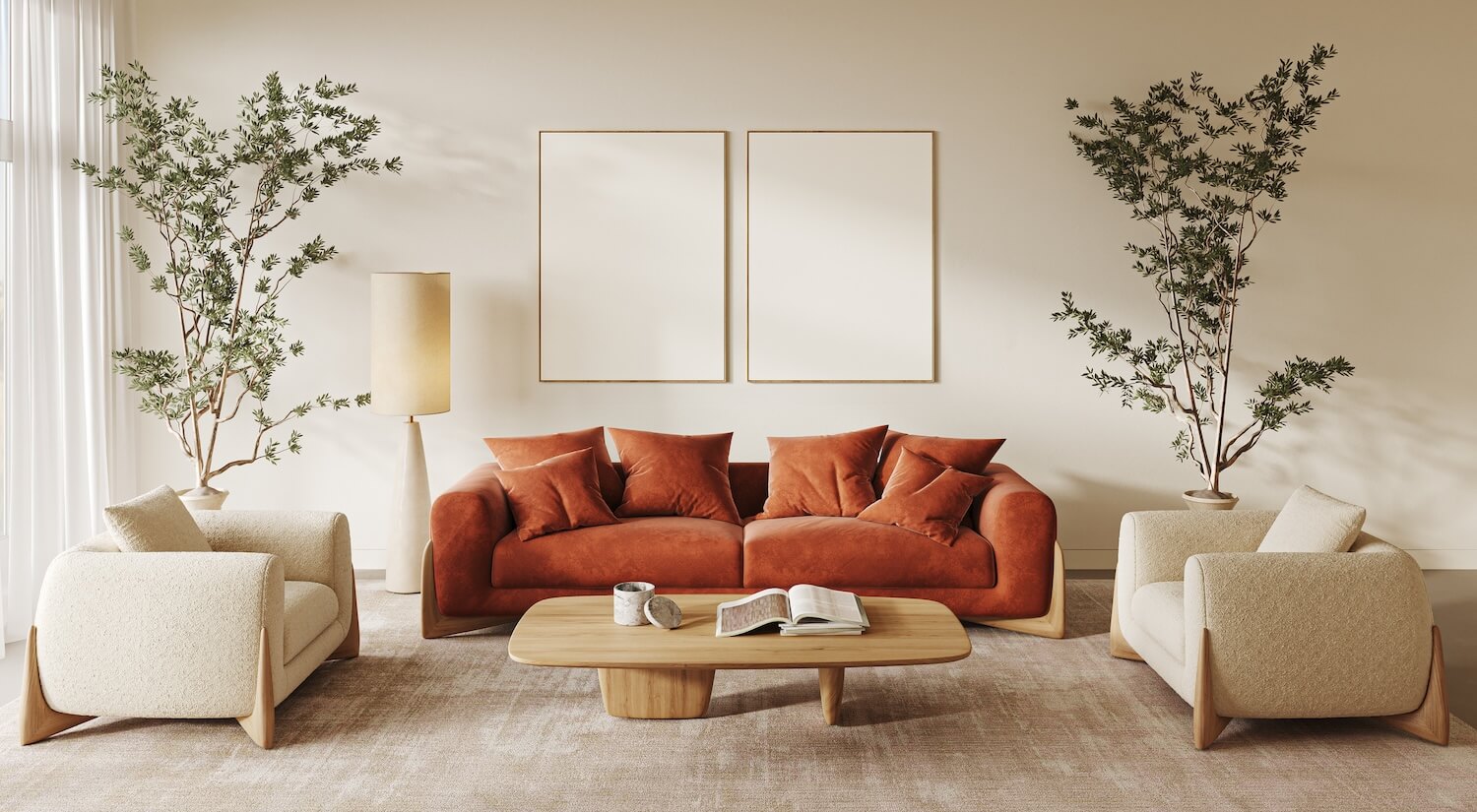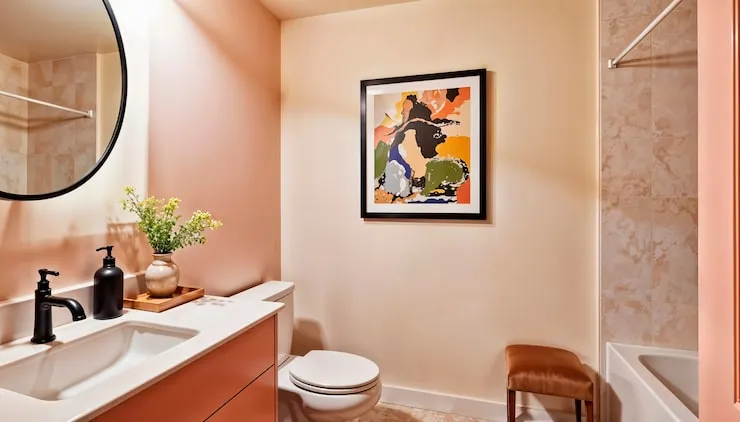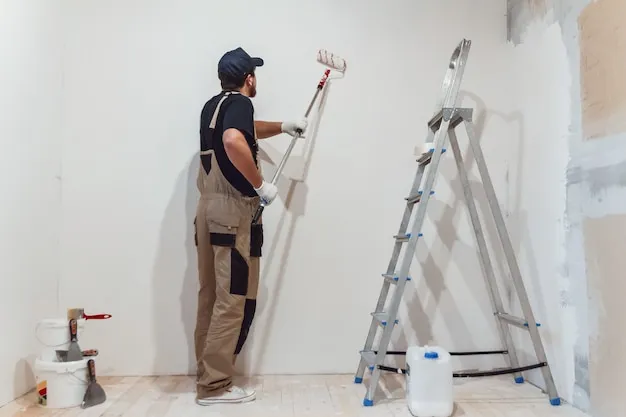When it comes to home renovations, selecting the right paint finish is as crucial as choosing the right color. Many homeowners consult interior house painters for advice on this matter, but it’s also helpful to have your own understanding. In our previous blog post, we discussed choosing between matte vs satin finish.
In this guide, we’re including other types of finishes. We’ll explore how to choose a paint finish that not only complements your space but also stands the test of time.
How to Choose a Paint Finish
What Are Paint Finishes?
Before diving into how to select a paint finish, let’s clarify what a paint finish is. Paint finish, also known as paint sheen, refers to the gloss level of the paint once it dries. The sheen affects how the color looks and how durable the paint is against wear and tear.
- Know Your Sheens: Choosing the right paint sheen is crucial for achieving the desired look and functionality in your home. Each type of sheen offers unique benefits and characteristics. Here’s a more detailed look at each one:
- Flat/Matte: This finish provides a non-reflective, smooth appearance, making it perfect for walls with imperfections. Flat or matte paint absorbs light, helping to hide small dings or rough patches. Best suited for low-traffic areas, it offers a classic, elegant look but requires more careful maintenance.
- Eggshell: Eggshell finish, with its subtle luster, is a step up from matte in terms of sheen. It’s easier to clean and more durable than flat paint, making it suitable for moderate-traffic areas like living rooms or dining rooms. Its slight gloss ensures better washability while still providing a warm and inviting look.
- Satin: Satin paint, known for its velvety sheen, is one of the most versatile finishes. It withstands cleaning and light scrubbing, making it ideal for high-traffic areas such as hallways, kitchens, and children’s rooms. This finish reflects light gently, creating a soft glow that enhances the colors.
- Semi-Gloss: This finish is more reflective and stands up well to moisture and cleaning, which makes it an excellent choice for trim, doors, cabinets, and bathrooms. Semi-gloss paint is particularly effective in areas that are frequently touched or exposed to water, offering both durability and an easy-to-clean surface.
- Gloss: Gloss paint is the most durable and reflective of the sheens. It’s typically used for accents like trim, furniture, or doors due to its high shine. This finish is highly resistant to scratches and easy to clean, making it practical for areas that need frequent wiping down. However, its high reflectivity can highlight surface imperfections.
Consider the Room’s Function
Understanding the specific needs of each room in your home is key when selecting a paint finish. Different rooms serve different functions and, as a result, have varying requirements for paint durability, moisture resistance, and aesthetic appeal.
Bathrooms and Kitchens
These spaces benefit significantly from semi-gloss finishes. This sheen level can withstand the steam and frequent cleaning these rooms often require. Its reflective quality not only adds a vibrant look to the space but also provides a practical solution for resisting mold and mildew, common concerns in wet environments.
Living Rooms and Dining Rooms
There’s moderate foot traffic in these areas, but less wear and tear compared to kitchens. An eggshell or satin finish is often ideal for these spaces. These finishes offer a balance between being easy to clean and not too shiny, creating a warm and inviting atmosphere. They can handle the occasional scrub, making them practical for spaces that see daily use.
Bedrooms and Other Low-Traffic Areas
A calm and relaxing ambiance is usually desired in bedrooms and other areas where there isn’t a lot of foot traffic. Flat or matte finishes are perfect for these rooms.
These sheens bring an elegant and sophisticated look, hiding imperfections on the walls. While they might not be as easy to clean as glossier options, their visual appeal in a bedroom, where the walls aren’t subjected to the same level of wear and tear as other areas of the house, is unmatched.
Home Offices and Study Rooms
Focus and serenity are important in these spaces. A combination of sheens can be used in these spaces. For instance, a flat or eggshell finish on the walls for a muted, distraction-free environment, complemented with satin or semi-gloss for trims or bookshelves, adding a touch of brightness and durability where it’s needed.
Children’s Rooms and Playrooms
Durability and ease of cleaning are essential in these areas. Satin finishes strike the right balance, offering a slight sheen that makes wiping off crayon marks or food splatters a breeze, while still contributing to a cheerful and playful atmosphere.
Think About Maintenance
When deciding on a paint finish, it’s important to consider the maintenance aspect. Higher gloss finishes, like semi-gloss and gloss, are notably easier to clean and more resistant to staining compared to their matte counterparts. This quality makes them an ideal choice in homes bustling with activity.
For families with pets or children, these higher sheen finishes can be a lifesaver. They withstand the wear and tear that comes with busy household life. Whether it’s muddy paw prints or crayon marks, a higher gloss paint can handle frequent cleaning without losing its luster.
In areas with heavy foot traffic, such as hallways and entryways, a durable paint finish ensures that the walls can be easily wiped down, maintaining their pristine appearance over time. This reduces the need for frequent touch-ups and repainting, saving time and effort in the long run.
Additionally, higher gloss finishes reflect more light, which can be beneficial in spaces that require regular cleaning. This reflection makes it easier to spot dirt and smudges, allowing for more effective maintenance.
Overall, when choosing a paint finish, considering the level of maintenance required for each type of sheen can help you select the most practical and long-lasting option for your home’s specific needs.
Consider the Aesthetic
The aesthetic appeal of a room is significantly influenced by the paint finish you choose. When reflecting on the desired ambiance, consider whether you prefer a sophisticated and shiny look or a more subdued and cozy atmosphere. This decision plays a crucial role in selecting the right sheen.
For a sophisticated, elegant look, higher gloss finishes like semi-gloss or gloss are ideal. These sheens reflect light, adding a vibrant and polished appearance to the space. They work wonderfully in formal living rooms or dining areas, where a touch of luxury is desired.
On the other hand, if you’re aiming for a relaxed and comfortable vibe, matte or flat finishes are the way to go. These sheens absorb light, creating a soft and warm feel that’s perfect for bedrooms or family rooms. Their lack of reflectivity lends a tranquil and inviting atmosphere, ideal for spaces meant for unwinding.
The aesthetic you choose should align with your personal style and the function of the room. Aesthetic preference is a subjective matter, and it’s important that the finish reflects your unique taste and the mood you want to set in your home. Ultimately, the right sheen will complement your decor and enhance the overall feel of your space, making it feel more like home.
Test Before You Commit
Before finalizing your paint selection, it’s essential to test the paint on a small section of your wall. This step is crucial in ensuring that the color and finish meet your expectations in real-world conditions. Paint can look remarkably different under various lighting situations and at different times of the day. By applying a test patch, you can observe how the paint interacts with natural and artificial light in the morning, afternoon, and evening.
This testing also allows you to see how the paint color complements your existing decor and room elements like furniture, curtains, and flooring. Sometimes, a color may appear perfect in a store or on a swatch but drastically change in your specific interior setting. Additionally, testing different sheens can help you understand how the finish will look once dry and how it will affect the overall ambiance of the room.
Observing the test area over a few days gives you a better perspective, especially as your eyes adjust to the new color. It helps in making a more informed decision, ensuring that you are completely satisfied with your choice before committing to painting the entire room. This simple step can save time, effort, and resources, and help you achieve the exact look and feel you desire for your space.
If you need guidance on how to test paint colors, here’s a helpful video that will show you how:
Expert Tips on Choosing the Right Finish
When selecting the perfect paint finish, there are several expert tips to consider. These insights will help you achieve a balance between aesthetic appeal and practical functionality. Let’s delve into some key advice:
When working with lighter colors, it’s important to be aware that glossier finishes can unintentionally highlight wall imperfections.
The reflective nature of high-gloss paints tends to accentuate even minor flaws on the surface. This is especially true in well-lit areas where natural or artificial light directly hits the walls. If your walls have dents, patches, or rough textures, opting for a matte or flat finish might be a better choice as these sheens diffuse light and help mask such imperfections.
Durability Matters
The durability of your paint finish is particularly important in high-traffic areas of your home, like hallways, kitchens, and children’s rooms.
In these spaces, walls are more prone to getting touched, bumped, or marked. A more durable finish, such as satin or semi-gloss, can withstand these challenges better. These finishes are not only tougher against physical wear but also easier to clean, making them ideal for maintaining the longevity and appearance of your walls.
Balancing Act
Achieving visual harmony in a room often involves mixing different paint sheens. This approach creates a dynamic yet balanced look.
For instance, using a higher sheen for trim, moldings, and door frames adds a subtle contrast against walls with a lower sheen. This technique not only delineates different architectural elements but also brings an element of sophistication to the overall design. The key is to find a combination that complements the room’s lighting, size, and color scheme, enhancing both its functionality and style.
At a Glance: How to Choose a Paint Finish
Here’s a table that might come in handy when you need to choose the right paint finish for your space:
| Sheen Type | Appearance & Characteristics | Best Suited For |
|---|---|---|
| Flat/Matte | Non-reflective, smooth, hides imperfections, absorbs light. | Low-traffic areas, walls with imperfections. |
| Eggshell | Subtle luster, more durable and easier to clean than flat. | Moderate-traffic areas like living rooms, dining rooms. |
| Satin | Velvety sheen, withstands cleaning and light scrubbing. | High-traffic areas like hallways, kitchens, children’s rooms. |
| Semi-Gloss | Reflective, stands up well to moisture and cleaning, durable. | Trim, doors, cabinets, bathrooms; areas frequently touched or exposed to water. |
| Gloss | Highly durable and reflective, resistant to scratches, easy to clean. | Accents such as trim, furniture, doors; areas needing frequent wiping. |
Conclusion
Choosing the right paint finish is an essential step in your home improvement journey. By considering the room’s function, maintenance needs, aesthetic preference, and testing your options, you can make an informed decision.
While this guide provides a solid foundation, don’t hesitate to consult the professional interior house painters at Better Painting for personalized advice tailored to your home.







